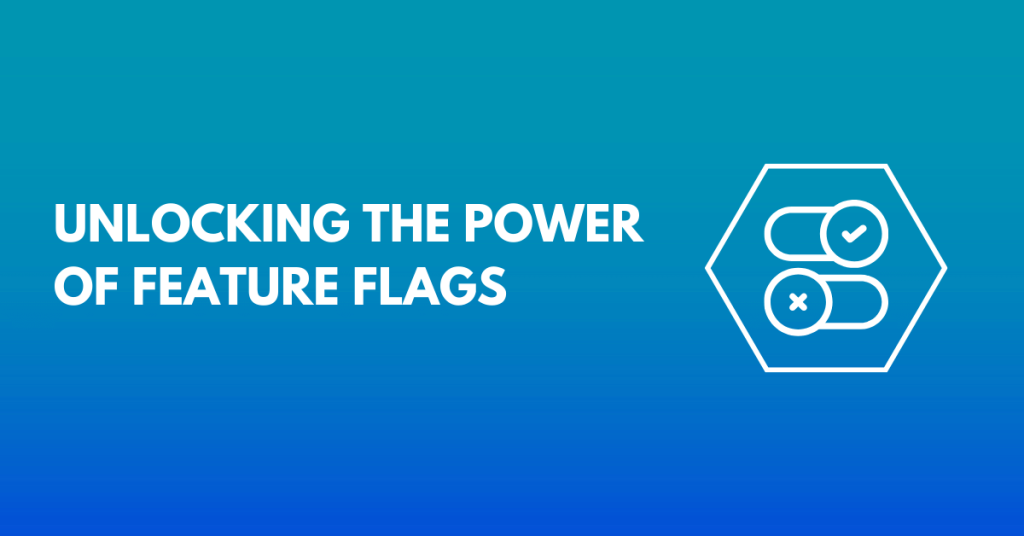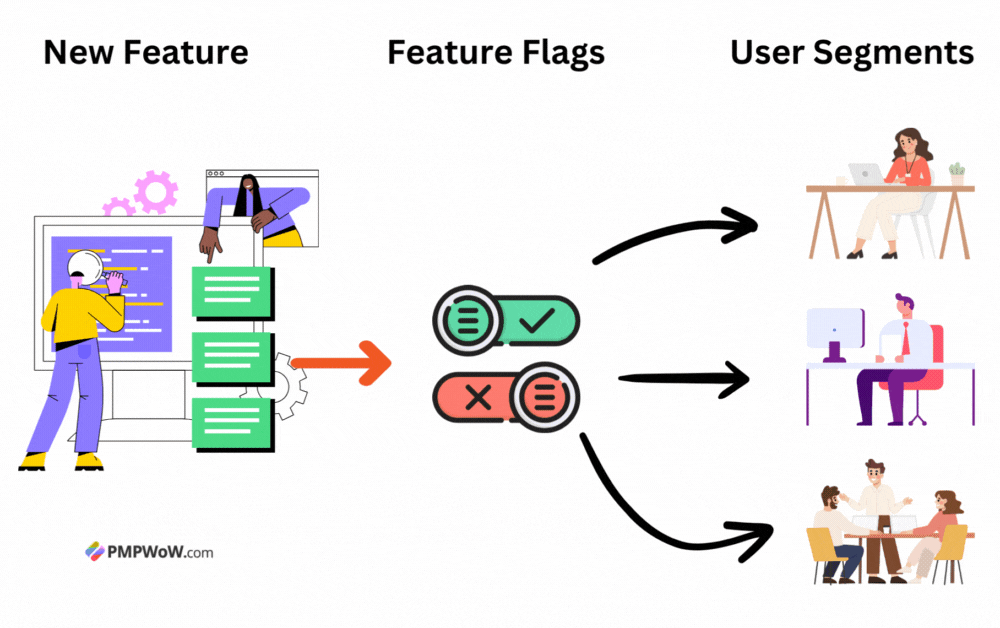
Utilizing Feature Flags enables you to switch features in your code on or off, granting you the ability to gradually introduce features to specific users or groups. Employing Feature Flags empowers you to oversee ongoing deployment and regulate which users have access to specific features and when they do. In this article, we’ll dive into the exciting world of feature flags, exploring their promises, versatility, and numerous applications. So, if you’re ready for a thrilling adventure in the coding world, folks, let’s embark on this journey together.
Benefits of Feature Flags
Faster Deployment, No More Waiting!
In the fast-paced digital fray, time is of the essence. Feature flags are the top-tier secret sauce for speedy deployments. Imagine being able to develop new features behind the scenes while your users continue to enjoy the existing ones without a hitch. It’s like having a superpower – the power to release new functionalities at the click of a button, without disrupting the user experience.
Reduced Risk: Stay in Control
In the software realm, surprises aren’t always pleasant. Feature flags offer you a safety net. When you’re experimenting with new features, there’s always a chance things might not go as planned. Feature flags allow you to seamlessly turn off a feature if it’s causing trouble, mitigating risks and ensuring a smooth user experience. It’s like juggling with safety nets, making sure nothing crashes down.
A/B Testing: Data-Driven Decisions
Ever wanted to know which version of your app or website users prefer? Feature flags make A/B testing a walk in the park. You can serve different versions of a feature to different user segments and gather real-time feedback. This data-driven finesse empowers you to make informed decisions based on user preferences, enhancing your product’s quality.
In this fast-evolving digital landscape, feature flags have become a vital tool, trusted and embraced by top-notch tech companies. But that’s just the beginning of our journey. In the next sections, we’ll delve deeper into common use cases, implementation best practices, and industry examples that showcase the power of feature flags. Stay tuned as we continue our exploration of this dynamic and versatile concept, all while keeping it clear, engaging, and human-friendly.
Common Use Cases
Progressive Deployment: Step by Step
Picture this: you’re launching a major update to your application. Instead of rolling it out to all users at once, you can use feature flags to gradually deploy it. Start with a small group of users, monitor for issues, and expand the rollout as you gain confidence. It’s like climbing a mountain – one step at a time, ensuring a safe ascent.
Testing New Features: The Playground
Every developer loves a playground to test their new toys, right? Feature flags provide just that. You can create a safe environment to test experimental features without affecting your entire user base. This sandbox-like approach allows for creativity and innovation while keeping things gentle and controlled.
Rollback and Recovery: Safety Net
In the unpredictable world of software, sometimes things go awry. Feature flags offer a reliable safety net. If a new feature causes unexpected issues, you can instantly turn it off, reverting to the previous state. It’s like having a trusty parachute when you’re skydiving – you hope you won’t need it, but it’s there when you do.

Implementation Best Practices
Feature Flagging Tools: Your Arsenal
To master the art of feature flags, you need the right tools. There’s a realm of feature-flagging platforms available, such as LaunchDarkly, Split.io, and ConfigCat. These top-notch tools provide a user-friendly interface for creating and managing flags, ensuring a smooth development journey.
Setting Up Feature Flags: The How-To Guide
Implementing feature flags requires finesse. You’ll need to sprinkle the codebase with flags strategically. But fear not, we’ll guide you through it, step by step. From simple if-else statements to more complex configurations, we’ll ensure you’re on the right path.
Naming Conventions: Stay Organized
In the world of feature flags, organization is key. We’ll unravel the secrets of effective naming conventions, ensuring your flags are easy to understand and manage. No more confusion in the code – we’ll have you orchestrating flags with finesse.
Stay tuned as we journey through the remaining sections, unraveling the challenges and pitfalls of feature flags, comparing them to traditional development, and exploring real-world industry examples. We’re here to provide you with a comprehensive guide that’s not just top-tier but also easy to follow and understand.
Challenges and Pitfalls
Technical Debt: The Unwanted Companion
While feature flags offer immense benefits, they can also lead to technical debt if not managed carefully. We’ll dive into strategies for keeping technical debt at bay, ensuring that your codebase remains clean and maintainable. Think of it as regularly tidying up your workspace to stay organized.
Complexity: Balancing Act
As you embrace feature flags, you’ll encounter increased complexity in your code. We’ll show you how to navigate this complexity with finesse, ensuring that your development process remains smooth and efficient. It’s like mastering a dance routine – challenging at first, but with practice, it becomes second nature.
Consistency in Flag Management: The Key to Success
Managing a plethora of feature flags can be overwhelming. We’ll provide tips on maintaining consistency, avoiding flag sprawl, and keeping your flags organized. Imagine managing a bustling circus – it’s all about keeping the acts synchronized.
Feature Flagging vs. Traditional Development
Contrasting Traditional Development
To truly appreciate the power of feature flags, we’ll draw a clear distinction between traditional development methods and the feature flag approach. You’ll see how feature flags revolutionize the development process, making it more adaptable and user-centric.
How Feature Flags Overcome Limitations
Every system has its limitations, but feature flags have a way of overcoming them. We’ll explore how feature flags tackle common development challenges, ensuring you’re always one step ahead in the game. It’s like having a versatile toolkit that adapts to any situation.
Industry Examples: Real-World Applications
Real-world Examples of Feature Flag Usage
We’ll take a deep dive into real-world case studies, showcasing how top-notch companies have leveraged feature flags to their advantage. You’ll see how feature flags have transformed industries and propelled innovation. These examples will serve as your compass in implementing feature flags effectively.
Benefits Realized by Leading Companies
From startups to tech giants, leading companies have reaped the benefits of feature flags. We’ll highlight their success stories, demonstrating how feature flags have become an integral part of modern development strategies. It’s like peeking behind the curtain to see the magic in action.
Future Trends in Feature Flagging
AI and Automation: The Future Is Here
As technology evolves, so does feature flagging. We’ll explore the role of AI and automation in the feature-flagging realm, giving you a glimpse of what the future holds. It’s like stepping into the world of tomorrow, where possibilities are endless.
Serverless Architectures: The Next Frontier
Serverless architectures are gaining ground, and feature flags are not far behind. We’ll discuss how feature flags fit seamlessly into serverless environments, making your applications more dynamic and efficient. It’s like upgrading from a reliable car to a spaceship.
DevOps Integration: A Harmonious Symphony
DevOps and feature flags go hand in hand. We’ll unravel the intricacies of integrating feature flags into your DevOps pipeline, ensuring a smooth and orchestrated development process. Think of it as a well-coordinated orchestra, with each instrument playing in harmony.
Continuous Delivery: The Future of Software Deployment
In the fast-paced digital world, continuous delivery is the name of the game. We’ll explore how feature flags enable continuous delivery, allowing you to deliver value to your users at an unprecedented pace. It’s like hitting the fast-forward button in the world of software development.
Conclusion
As we reach the end of this comprehensive guide, you’ve embarked on a journey through the exciting realm of feature flags. We’ve covered their benefits, common use cases, best practices, challenges, and future trends. Feature flags are not just a tool; they are a game-changer that empowers developers to create, test, and deploy with finesse.
So, if you’ve ever wondered, “What are feature flags used for?” – you now have the answers. It’s time to embrace this versatile concept, experiment, and transform your development process. With feature flags, you’re not just staying in the game; you’re leading it. Thank you for joining us on this adventure. Stay curious, stay innovative, and keep exploring the dynamic world of technology. Your next coding breakthrough might just be a feature flag away.





